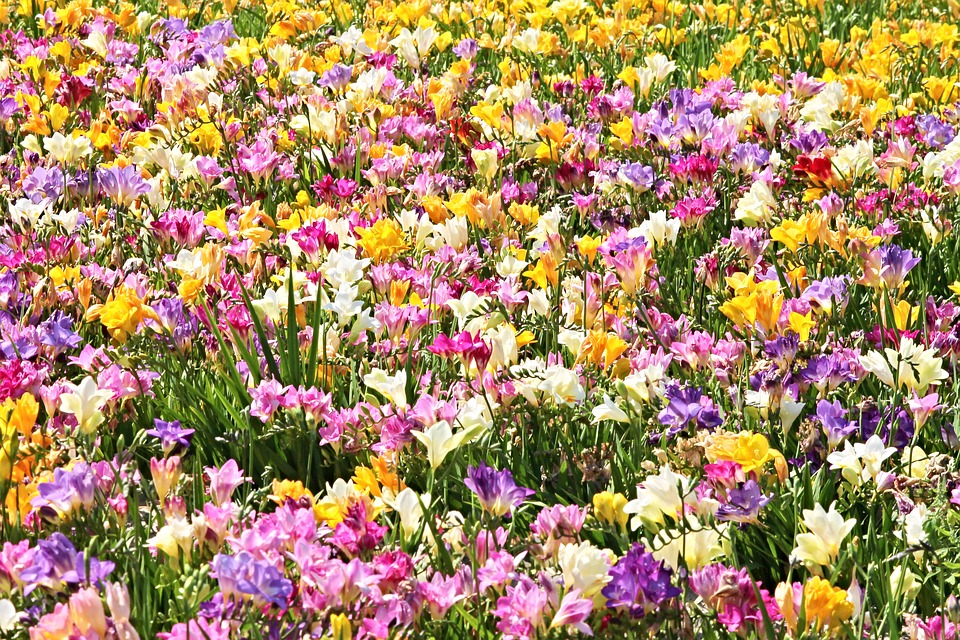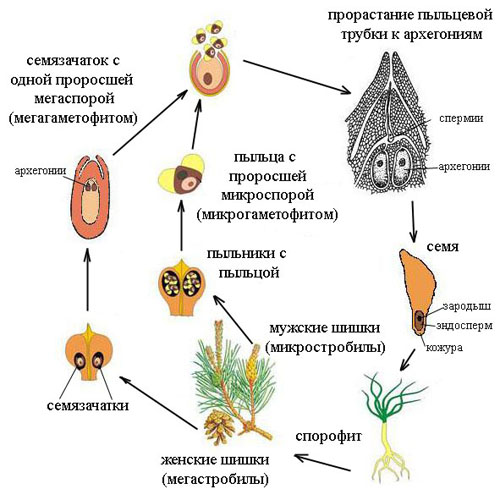In the plant world, the most perfect and numerous group is the department of angiosperms or flowering plants. These include all plants that are equipped with an organ of seed propagation - a flower. In total, there are more than 350 thousand different types of plants on the planet, and of which ¾ part belongs to angiosperms. They can calmly grow in water, arid deserts and a multi-colored carpet cover the land of the steppes. This article will examine the life cycle of angiosperms, which are well adapted to various environmental conditions and distributed from the icy Arctic to Antarctica.
Definition
Angiosperms or flowering plants are plants whose seed organ is the flower. These include grasses, flowers, shrubs and trees. Male and female gametes (reproductive cells) develop in flowers. Seeds are located inside the ovary, in the fruits, hence the name - angiosperms. Flowers vary in shape, size, structure and color. In some plants they are pollinated by the wind, in others by insects. The growing season is also different for everyone - from several weeks (for ephemers) to hundreds of years (for oak). All angiosperms have different heights. There are many plants with erect stems, but there are creeping, creeping and climbing stems. The root system and leaves are quite diverse. Despite this difference, there is a certain angiosperm life cycle. All plants are grouped by characteristic features. The main criterion of taxonomy is the degree of kinship between plants. All flowering are divided into two classes - dicotyledonous and monocotyledonous.

They are of great importance both in nature and in the life of an individual. Some of them are eaten by people, while others go to feed domestic and wild animals. Plant materials are used in various industries. Ornamental plants are used for landscaping, woody - for construction, medicinal - in traditional and folk medicine.
Angiosperm Development Cycle
There is a generational change. Thanks to meiosis, spores form, and gametes are the result of mitosis. Both those and others are formed in a flower. Therefore, it is called the organ of sexual and asexual reproduction. In pollen grains (microspores), male gametes are formed in large quantities, which are carried by insects or wind on the stigma of the pestle.
This phenomenon allows angiosperms to do without floating sperm. At all stages of development, both embryos and sperm with egg cells are under reliable protection of saprophyte tissue. The result is a high viability of flowering flora representatives.
Flower structure
The cycle of angiosperms is an alternation of generations of the gametophyte (sexual) and sporophyte (asexual), which is represented by an ordinary plant consisting of a stem, root, leaves and flower.
The corolla of the petals of the latter and the green sepals are a protection for the female part of the flower (pistil) and the male part (stamens). The pestle includes a stigma, a column and an ovary with an egg. Stamens are endowed with the ability to produce pollen, which, once in the ovary, fertilizes the egg. As a result, a seed is formed. The fruit, which protects the seed and allows it to spread, arises from the ovary.
Features of angiosperms
The exclusivity of these plants is as follows:
- Double fertilization. From one seed, after contact with the egg, a zygote arises. Further, an embryo is formed from it. From the second, a triploid cell is formed, subsequently leading to the development of an endosperm containing nutrients.
- Pollen initially enters the stigma of the pestle and further into the pollen entrance of the ovule. The latter is protected from damage, as it is enclosed in a pistil cavity of the ovary.
- The presence of a flower makes it possible to propagate by seeds.
- The female gametophyte is the germinal sac, and the male is pollen grain. They develop quite quickly and are greatly simplified, unlike other plants. On the other hand, they are under constant protection and depend on the sporophyte.
- In the life cycle of angiosperms, diploid sporophyte predominates.
Diversity
The variety of life forms and sizes of angiosperms amazes the imagination of the individual. For example, the smallest representative is duckweed wolfia, its diameter is about one millimeter. And on the other hand - a giant eucalyptus, reaching a height of one hundred meters. Thus, among the flowering ones, there are:
- herbs;
- Shrubs
- trees;
- shrubs;
- creepers and others.
The first three are considered basic. Shrubs and trees are perennial. Some species of trees can live for more than a thousand years. Among herbaceous plants there are many annuals. During the growing season, they go through the entire life cycle of angiosperms. Briefly, this can be described as follows:
- They grow from seeds.
- Are blooming.
- Form seeds.
- Die off.
Quite a lot in nature of perennial and biennial species of herbs. In cases where they grow in places where winters are cold, the green ground part dies during the period of cold weather. However, tubers or rhizomes remain in the ground, having a certain supply of nutrients. In spring, a new green part of the plant forms. It is important to remember that biennial plants produce fruits and bloom only in the second year, and then the plant dies. And perennials annually delight with flowering. Here is such a different life expectancy of angiosperms. In addition, saprophytes, parasites, and semi-parasites, which completely lost the ability to photosynthesis, are found among flowering ones.
The main differences in the propagation of angiosperms and gymnosperms
The presence of a flower in which spores appear and hatch, forming the female and male sexual generation with gametes, is also considered exceptional, and pollination, gynogenesis, and seed development are carried out. In angiosperms gametophytes, seeds are formed in pistils and stamens, and not in cones, as in gymnosperms. In angiosperms, ovules form inside the pestle, unlike gymnosperms. Thanks to this, they are securely hidden and protected from poor environmental conditions. After fertilization, an ovule seed is formed, and the fetus arises from the bottom of the pestle. The next difference is the double fertilization of the flowering ones, i.e., their endosperm is formed after, and in gymnosperms, before fertilization. In addition, only angiosperms have vegetative parthenogenesis. Thus, the life cycle of angiosperms is somewhat different than that of gymnosperms of the plant world.
The difference between sexual reproduction and vegetative
Flowering plants are inherent in both sexual and vegetative propagation. The first is associated with the flower, as it is considered a reproductive organ. From the zygotes formed as a result of fusion of gametes, the embryo of a new plant subsequently develops.
And with the vegetative method of propagation, new representatives are formed due to the regeneration of leaves, shoots, roots, i.e., vegetative organs.
Gymnosperms
When propagated, these representatives of the plant world produce seeds, not spores. In addition, they do not form fruits, and their seeds are not protected and are located on the surface of the cone flakes. Larch, pine, spruce - these are the most famous examples of gymnosperms. In most cases, instead of leaves, needles (needles). Coniferous plants make up a large group of gymnosperms, and they are also represented by vines, trees, and shrubs. There are no herbs in the gymnosperms department. All gymnosperms are evergreen perennials with a high life expectancy. From ovules, seeds develop that have nutrients in the skin, which is considered an important advantage over spore plants.
Gymnosperm cycle
The life cycle of gymnosperms and angiosperms has some differences. The former are dominated by the asexual generation, and the gametophyte develops on the sporophyte. Let us consider in more detail the development of gymnosperms on the example of an evergreen tree (pine). An adult plant is a sporophyte. Spores ripen in the so-called sporangia, located in the cones. Moreover, male and female differ in color: the first is yellow, and the second is red in the first year. At the end of spring (in May) and at the beginning of the first summer month, male spores fall out of their houses and, with the help of the wind, move to cones of the opposite kind. Female spores germinate inside the sporangia, forming a growth with two organs. It is in them that the development of the egg takes place, that is, the growth is a gametophyte. He is the new generation of pine and at the same time the maternal organism for the future embryo. Male gametophyte is the pollen from which sperm are formed.

In the first year, gametes of both sexes are immature, so there is no fertilization. The female cones after pollination are closed, and throughout the year male and female gametes develop in them. A year later, fertilization is carried out in female greened and lignified cones. The first sporophyte cell is a zygote, which divides and a new embryo is formed from new cells, which has a root and shoot, i.e., vegetative organs. Around it, a shell appears and nutrients are deposited. So the seed is formed in the female cone. In the third year, they acquire a brown tint and open. As a result, the seeds fall into the soil and germinate, a young pine appears - sporophyte.
Conclusion
More than 350 families, about thirteen thousand genera and more than three hundred thousand species of angiosperms are known. These autotrophic organisms are an important component of the Earth's shell.
Flowering plants dominate gymnosperms. They make it possible for the animal world to exist. It is proved that some groups of animals were born only after angiosperms flooded the Earth. This is perhaps the only group represented among higher plants, instances of which were able to re-develop the marine environment, that is, various species of flowering live together with algae in salt water.